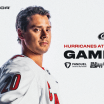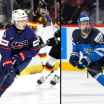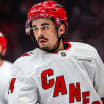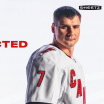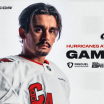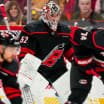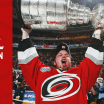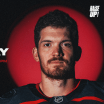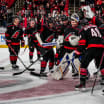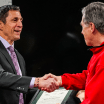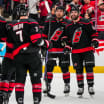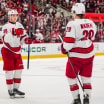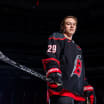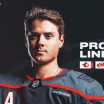Burnside: The Humble Beginnings Of Hurricanes Hockey
Looking back on how the NHL got its footing in North Carolina
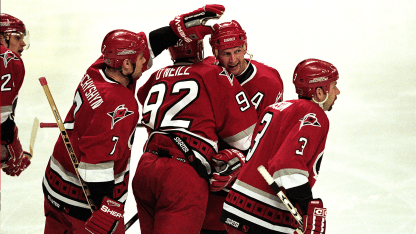
Let's be honest, 25 years later and with the Carolina Hurricanes riding a string of success that has seen them make the playoffs for a franchise-record four straight seasons, not to mention having become a destination market for free agents and considered a top Stanley Cup contender, the line that links the past from the present is blurry at best.
Maybe that's how it's supposed to go. The closer you get to the summit the less you think about the base camp.
Longtime GM Jim Rutherford, the man who almost single-handedly orchestrated the unheard of feat of moving a professional franchise from one city to another in less than half a year, said as much.
"Fans care about where the team is at now," said Rutherford.
Still, maybe that's exactly why this is a good time to pause and reflect on the path carved out of the hockey wilderness in North Carolina. Maybe it's important to remember the days when Rutherford, now the President of Hockey Operations in Vancouver, looked out his temporary office window beneath the flight path of virtually every plane taking off and landing at RDU Airport and wondered how or whether this was all going to come together.
Maybe to really appreciate the present you have to acknowledge, embrace the past.
And really, the Carolina Hurricanes' past is unlike that of any other NHL team. Maybe any other pro franchise.
The Hartford Whalers joined the NHL in 1979, one of four former World Hockey Association teams to make the jump to the senior circuit. The Whalers' time in Hartford was marked by a close-knit group of players and staff off the ice, on-ice disappointment and struggles financially in one of the league's smallest markets.
Detroit area businessman Peter Karmanos bought the team in 1994. The team's new GM was Karmanos's associate and long-time NHL netminder Jim Rutherford, who soon brought in junior hockey head coach Paul Maurice.
In early 1997 talks aimed at building a new arena in the Hartford area fell apart and word leaked that the team would be moving before the start of the 1997-98 season.
"This happened very quickly," Rutherford said.
Karmanos was still considering a couple of options for his team's new home when team officials met with local business leaders in Raleigh like Steve Stroud.
"All those people did a terrific job," Rutherford said.
And so the Carolina Hurricanes were born. But it would be a difficult delivery to be sure.
In a market dominated by college sports, especially college basketball and NASCAR, hockey and specifically NHL hockey was the new kid on the block. The transition to the untraditional market was exacerbated by the fact the team's permanent home in Raleigh wouldn't be ready for two seasons.
There were discussions about playing in a smaller facility at the state fairgrounds but the NHL worried about the optics about playing in a temporary facility and so it was decided the team would make Greensboro and the Greensboro Coliseum home for the first two seasons.
"It was pretty clear it was going to take a little time to get the franchise to where it needed to get to," Rutherford said. "It was not easy on anybody."
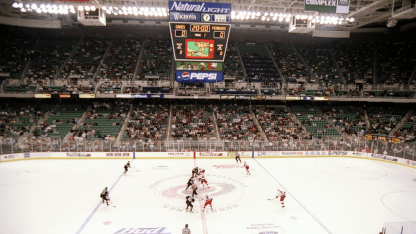
What were those first days like?
"I hope you've got all day," John Forslund said.
Forslund, a successful broadcaster in the American Hockey League, had joined the Whalers in their public relations department and graduated to calling Whalers games after Karmanos bought the team.
He, like many with strong connections to Hartford, had mixed feelings about the move. In fact at one point it looked as though Forslund would end up staying in the northeast as he was courted by the Boston Bruins. But Rutherford appealed to Forslund to make the move with the team to Raleigh and Forslund became a part of the fabric of not just the team, but the community in North Carolina.
"I'm just so glad he did," Forslund said. "It was the greatest thing."
Still, this was very much a journey into the unknown for all the players and staff who moved from Connecticut to North Carolina.
"I was nervous. I was scared," Forslund admitted. He and his wife had just bought a house in Maine. Their oldest daughter was a year old and his wife was eight months pregnant with their son.
This wasn't an expansion team a la Vegas or Seattle with literally months to prepare for a launch and to cultivate a fan base.
"This was basically moving to a place where basically they didn't know why we were coming," Forslund said.
"It was a circus," Forslund added. "Those two years were unbelievably hard."
Nelson Emerson, now the assistant GM of the Los Angeles Kings, had a young daughter and another on the way when they made the move with the rest of the Whalers.
"We didn't know what to expect. We really didn't," Emerson said. "It was quite a shock."
"Everyone was trying to figure out the best thing to do," he added. "We just kind of all came together and figured it out. It wasn't easy."
Emerson fell into a pattern of driving to Greensboro with future Hall of Famer (and later Hurricanes GM) Ron Francis.
"I was getting an education every day in the car," Emerson said. "We were all open to anything," Emerson added.
"I wouldn't have traded any of it for anything."
Initially the team would drive early on game day mornings to Greensboro for the morning skate, sleep in a hotel in the afternoon and then drive home to Raleigh after the games.
Later the team would skate in the morning in Raleigh and then drive up for the games. But it was all very fluid, all a work in progress.
Jeff O'Neill was part of a talented group of young players on that first Hurricanes team. He liked to be in Greensboro the night before games to avoid the game-day drive.
"It was very challenging, very challenging," O'Neill said.
"I was a 19-year-old kid. I really didn't know what the heck was going on to begin with," O'Neill recalled. "I knew nothing about Raleigh-Durham. I had no idea even where it was."
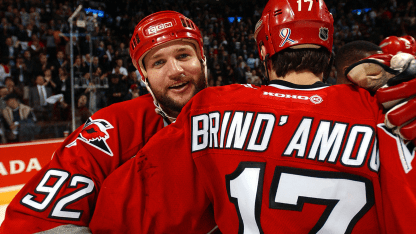
Many credit veteran captain Kevin Dineen for being a stabilizing influence on the team as they made the dramatic move. Dineen had been a Hartford Whalers draft pick, played eight seasons with the Whalers, left and then came back to the team in time for the team to move south.
Dineen worked tirelessly to make sure the players and their families were connected as they confronted the challenges that awaited them in North Carolina.
"Instead of going through it alone we did it all together," said Dineen, who is currently the head coach of the New Jersey Devils' top farm team in Utica.
Housing, schools, restaurants, childcare.
"All those little challenges that you deal with we all did that together," Dineen said.
The organization was instrumental in all this.
"Jimmy had his fingerprints on the pulse of what the guys needed," Dineen said of Rutherford.
Dineen lived near Stu Grimson and O'Neill and the trio would regularly stop and grab and coffee and then make the trek to Greensboro.
"There was a lot of bonding that goes on when you're spending that much time together," Dineen said.
He, like Emerson, never made it to the new rink in Raleigh. Emerson was traded in the middle of the second season while Dineen signed as a free agent with Ottawa in the summer before the 1999-2000 season. But their impact on the culture of the young team cannot be understated.
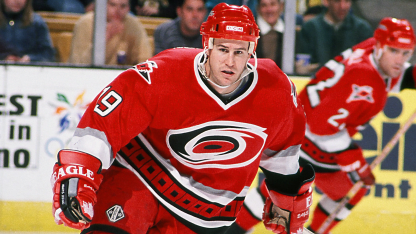
Few have the perspective on those early years that long-time color analyst Tripp Tracy possesses. He arrived in Greensboro for that first-ever training camp as a young netminder trying to crack the NHL roster.
He started the season in New Haven and when he was called up for a few days to the big club, he traveled from the Hartford airport with another young player in Bates Battaglia, who would not only play a big role in the team's evolution but would remain a fixture as a local businessman in Raleigh long after he retired.
The only time Tracy dressed for an NHL game was in Greensboro during that inaugural season.
The next fall, just before the start of the team's second season in Greensboro, the Hurricanes needed a color analyst and turned to the unproven Tracy.
Often he traveled with Hall of Fame radio broadcaster Chuck Kaiton, frequently stopping along the way to pick up a new collection of Kaiton's beloved cigars. During the long game days in Greensboro, Tracy, Kaiton and Forslund would have lunch and then hang out at the arena.
"They had to be like, 'what the heck is going on here?' Me, I feel like I'm a kid in an amusement park," Tracy said with a laugh.
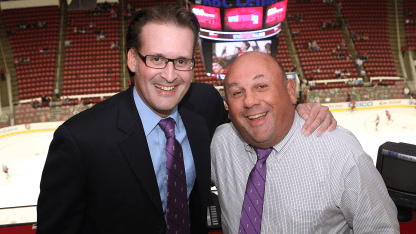
Opening night in Greensboro 1997?
How much time do you have.
The locker rooms were still being completed hours before the first-ever NHL game in North Carolina.
And then there was the big reveal of Stormy the mascot.
Forslund recalls it as though the event took place yesterday, not a quarter of a century ago.
The lights were down on the end of the rink where the Zamboni entered the ice surface. At the other end, under a spotlight, the oldest pig caller in the state of North Carolina. Forslund estimated the caller's age at mid-90s. And yet he was calling into the microphone with great enthusiasm; Sooo-eee, Sooo-ee.
Ice maker and Zamboni driver Donnie MacMillan, who came with the team from Hartford and actually lived for a time in his RV at the arena in Raleigh, was driving the ice resurfacing machine in which Stormy was ensconced waiting for his big moment.
Smoke, courtesy of dry ice packed into the Zamboni, billowed from the resurfacing machine.
The hog-calling continued and the public address announcer called on Stormy to emerge from the insides of the machine while a sellout crowd waited in anticipation.
But nothing happened.
"Well, Stormy was being asphyxiated," Forslund said.
MacMillan, sensing something was wrong, abruptly turned the Zamboni and raced for the exit from whence it had come.
"The poor kid went to the hospital but he was okay," Forslund said.
In fact the young man ended up keeping the mascot gig for a while during the team's stay in Greensboro.
ESPN didn't broadcast that initial sold out game. But they did do the second game setting the stage for what would be ongoing jokes about the team's appeal in the south.
"We might have had 1,000 people at the game," Forslund recalled.
And so it would go for two seasons.
"It was a weird situation," O'Neill said. "It didn't really have an NHL vibe to it."
Not that you could blame the fans in Greensboro, what few there were who showed up to games. They knew this was a temporary thing.
"They had no skin in the game," Dineen said. "They knew we were just carpetbagging for a couple of years."
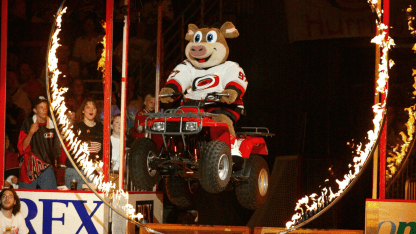
The story of those early days of the team would also be marked by great tragedy.
The Hurricanes made the playoffs in their second season in Greensboro and after losing to Boston in six games, popular defenseman Steve Chiasson died in an alcohol-related accident following a team party.
It was devastating.
"That was the darkest moment," Forslund said. "That's where it felt like after all this, this has happened."
The grieving process was another part of the team's coalescence. That was brought home when Chiasson's wife, Sue, and the couple's children Mike, Ryan and Stephanie attended a game against Calgary in November and dropped the ceremonial first puck.
The team honored Chiasson that season with a patch worn on their jerseys and to this day the Hurricanes give out an internal award in Chiasson's honor recognizing a player who demonstrates the qualities of determination and dedication and being an inspiration to his teammates through his performance and approach to the game.
As painful a moment as that was for the fledgling franchise, it also remains a reminder of the complex nature of creating a team and of doing the right things in the face of the unthinkable.
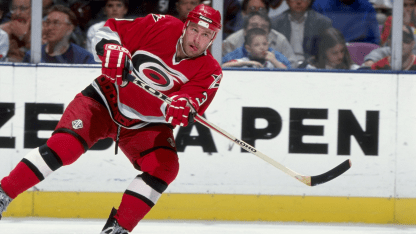
The Hurricanes stayed close that first season in Raleigh, missing the playoffs by a point.
The following season, 2000-01 they qualified for the playoffs and played the powerful New Jersey Devils. The Hurricanes dropped the first two games, tied the series at 2-2 and dropped Games 5 and 6. That final game at home wasn't close. And yet as the third period wound down the fans rose to celebrate the team's will and determination even in a losing moment.
"For me that's the moment," Tracy said. That was the moment that seemed to galvanize the connection between the fan base and the team. "And that as long as you had a true team and work ethic they were going to support you unconditionally. The seeds were planted then with regards to a fan base."
A year later, the team would advance to their first-ever Stanley Cup final.
This process of marrying team and community wasn't just about trying to coerce paying fans through the door to that brand new arena in Raleigh. It was about trying educate a fan base, the majority of whom had only a passing knowledge if that of the game.
Because to know the game is to love it.
"Good people trying to do good things," O'Neill said of those early days. "That's what it was all about."
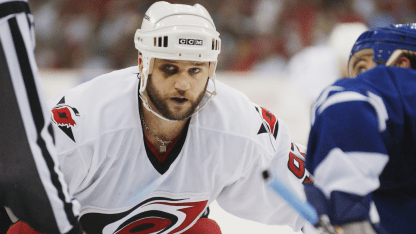
Now a high-profile broadcaster based in Toronto, O'Neill was a Hurricane for seven seasons before finishing up his career with the Maple Leafs. He recalled the tour of the new facility in Raleigh and those first games at their real home at the Raleigh Entertainment And Sports Arena as a kind of benchmark.
"That was when it clicked in," O'Neill said. "That first game and the place is packed. That's where you're, okay, I play in Raleigh, we're the Hurricanes, this is going to be a fun place to play."
These formative years were traversed long before social media and other forms of electronically gathering like-minded people. For the players, management, broadcasters, sales people there were countless public appearances and visits with service groups, fundraising runs and walk-a-thons and charity hockey games all to spread the word about the Hurricanes.
"We did a lot of stuff in the community. I spent a lot of time with charities outside the team, with the team," Forslund said. "That was really important. We had to earn our cred."
Rutherford stepped down as Hurricanes GM in the spring of 2014 and then led Pittsburgh to back-to-back Stanley Cups in 2016 and 2017 as GM there.
He was inducted into the Hockey Hall of Fame in 2019.
In spite of his various career stops along the way, Rutherford remains strongly connected to the team and to the community. He acquired captain Jordan Staal, drafted Brett Pesce and Jaccob Slavin and remains close friends with head coach Rod Brind'Amour whom he acquired in a trade on January 23, 2000. He still calls Raleigh home.
"I feel that connection and have a real strong friendship with Roddy and so I'm hoping for them," Rutherford. "I cheer for them. It's a great market with great people there and great sports fans. I'm happy to see the direction it's going."
Kevin McCarthy had been on the Whalers' coaching staff in Hartford under Paul Holmgren prior to Maurice taking over. Rutherford had asked him to coach the team's American Hockey League affiliate first in Springfield and then in New Haven before McCarthy joined the Hurricanes and Maurice for that first season in Raleigh in 1999-2000.
McCarthy recalled his wife Rhonda attending one of the early games in Raleigh and listening to a group of fans sitting near her lamenting how quickly Maurice was changing his players. Just when the skaters were getting into the game off the ice they would go replaced by five more. How did that make any sense, the fans asked each other.
For a fan base growing up on basketball this was part of the learning curve.
That memory is nicely juxtaposed against the memory of Game 7 of the 2006 Stanley Cup final in Raleigh, a game during which fans remained standing for the entire game right through NHL Commissioner Gary Bettman handing the Stanley Cup to captain - and of course now head coach - Rod Brind'Amour.
"The people had no idea how hockey worked," McCarthy said.
But they learned. Just as McCarthy and his family learned to love being in Raleigh.
"We absolutely loved it," said McCarthy, who was an assistant in Carolina until December 2009 and who remains an assistant to former Hurricanes head coach Peter Laviolette in Washington.
McCarthy recalled buying his Christmas tree while wearing shorts and then calling his family back in his hometown of Winnipeg to boast about the weather.
"I'd always call them and rub it in," McCarthy said.
In many ways this remains home for the McCarthys just as it is in many ways home for Forslund and Rutherford and so on.
For the many players and staff who made their homes in the Raleigh area in those early days and who raised their families there this wasn't just a job but a labor of love.
That's what resonates for Forslund as he reflects on the journey that involved not just his own professional ascendency to the top of his craft but his family's growth in the community.
"You're like a pioneer," said Forslund, one of the most popular broadcasters in the game who is the play-by-play voice of the Seattle Kraken and appears periodically on national broadcasts.
Forslund's son Matthew played on the first-ever squirt AAA team.
"They got destroyed everywhere they went to play," Forslund recalled with a laugh.
Head coach Peter Laviolette's son played on that team. So did Cory Stillman's son, Riley, who is in the Vancouver Canucks' organization.
It was a tradition that continues to this day with Brind'Amour and long-time Hurricane Justin Williams, both coaching their kids and other teammates' children on youth teams playing out of the team's new practice facility.
Forslund was witness to all of those formative moments, the trip to the '02 final, the Cup win in 2006 and a run to the conference of final in '09 followed by a decade of futility. He played a pivotal role when the community hosted the draft and the NHL All-Star event. He was witness not just as a broadcaster and part of the team but a member of the community whose family still has deep ties to the Raleigh area.
"At the risk of being really cliché, there were so many different things that were special," Forslund said. "It's hard to say one more than the other."
Those early struggles, so far in the past now, are nonetheless part of the team's DNA. They are part of the identity of the team and the entire community.
"Each step we took it got better and better and better," Forslund said. "Fans started to put their arms around our team."
Worth A Click:
Sign Up To Watch Carolina Hurricanes Hockey Through Bally Sports+
2022-23 Single Game Tickets On Sale Now
Mailbag #39: Through The First Four
Svechnikov Scores Three, But Canes Fall To Oilers
Canes Reveal Reverse Retro 2022 Jersey
Canes Announce Giveaway Schedule
Canes Announce Home Uniform Schedule
Hurricanes Hall of Fame Established

